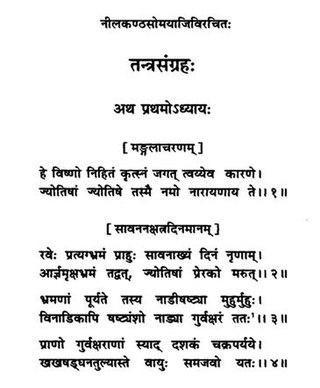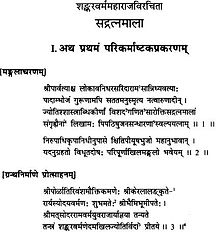The Hindu calendar, also called Panchanga, is one of various lunisolar calendars that are traditionally used in the Indian subcontinent and Southeast Asia, with further regional variations for social and Hindu religious purposes. They adopt a similar underlying concept for timekeeping based on sidereal year for solar cycle and adjustment of lunar cycles in every three years, but differ in their relative emphasis to moon cycle or the sun cycle and the names of months and when they consider the New Year to start. Of the various regional calendars, the most studied and known Hindu calendars are the Shalivahana Shaka found in the Deccan region of Southern India and the Vikram Samvat (Bikrami) found in Nepal and the North and Central regions of India – both of which emphasize the lunar cycle. Their new year starts in spring. In regions such as Tamil Nadu and Kerala, the solar cycle is emphasized and this is called the Tamil calendar and Malayalam calendar and these have origins in the second half of the 1st millennium CE. A Hindu calendar is sometimes referred to as Panchangam (पञ्चाङ्गम्), which is also known as Panjika in Eastern India.

Aryabhata or Aryabhata I was the first of the major mathematician-astronomers from the classical age of Indian mathematics and Indian astronomy. His works include the Āryabhaṭīya and the Arya-siddhanta.

Bhāskara II, also known as Bhāskarāchārya, and as Bhāskara II to avoid confusion with Bhāskara I, was an Indian mathematician, astronomer and inventor. From verses, in his main work, Siddhānta Shiromani (सिद्धांतशिरोमणी), it can be inferred that he was born in 1114 in Vijjadavida (Vijjalavida) and living in the Satpuda mountain ranges of Western Ghats, believed to be the town of Patana in Chalisgaon, located in present-day Khandesh region of Maharashtra by scholars. He is the only ancient mathematician who has been immortalized on a monument. In a temple in Maharashtra, an inscription supposedly created by his grandson Changadeva, lists Bhaskaracharya's ancestral lineage for several generations before him as well as two generations after him. Colebrooke who was the first European to translate (1817) Bhaskaracharya II's mathematical classics refers to the family as Maharashtrian Brahmins residing on the banks of the Godavari.
Keļallur Nilakantha Somayaji, also referred to as Keļallur Comatiri, was a major mathematician and astronomer of the Kerala school of astronomy and mathematics. One of his most influential works was the comprehensive astronomical treatise Tantrasamgraha completed in 1501. He had also composed an elaborate commentary on Aryabhatiya called the Aryabhatiya Bhasya. In this Bhasya, Nilakantha had discussed infinite series expansions of trigonometric functions and problems of algebra and spherical geometry. Grahapariksakrama is a manual on making observations in astronomy based on instruments of the time. Known popularly as Kelallur Chomaathiri, he is considered an equal to Vatasseri Parameshwaran Nambudiri.
Āryabhaṭa also known as Arya Diya Jankhi was an Indian mathematician and astronomer, and the author of the Maha-Siddhanta. The numeral II is given to him to distinguish him from the earlier and more influential Āryabhaṭa I. Scholars are unsure of when exactly he was born, though David Pingree dates of his main publications between 950–1100. The manuscripts of his Maha-Siddhanta have been discovered from Gujarat, Rajasthan, Uttar Pradesh, and Bengal, so he probably lived in northern India.
Śrīpati, also transliterated as Shri-pati, was an Indian astronomer, astrologer and mathematician. His major works include Dhīkotida-karana (1039), a work of twenty verses on solar and lunar eclipses; Dhruva-mānasa, a work of 105 verses on calculating planetary longitudes, eclipses and planetary transits; Siddhānta-śekhara a major work on astronomy in 19 chapters; and Gaṇita-tilaka, an incomplete arithmetical treatise in 125 verses based on a work by Shridhara.
Indian mathematics emerged in the Indian subcontinent from 1200 BCE until the end of the 18th century. In the classical period of Indian mathematics, important contributions were made by scholars like Aryabhata, Brahmagupta, Bhaskara II, and Varāhamihira. The decimal number system in use today was first recorded in Indian mathematics. Indian mathematicians made early contributions to the study of the concept of zero as a number, negative numbers, arithmetic, and algebra. In addition, trigonometry was further advanced in India, and, in particular, the modern definitions of sine and cosine were developed there. These mathematical concepts were transmitted to the Middle East, China, and Europe and led to further developments that now form the foundations of many areas of mathematics.
Mādhava of Sangamagrāma (Mādhavan) was an Indian mathematician and astronomer who is considered as the founder of the Kerala school of astronomy and mathematics in the Late Middle Ages. Madhava made pioneering contributions to the study of infinite series, calculus, trigonometry, geometry, and algebra. He was the first to use infinite series approximations for a range of trigonometric functions, which has been called the "decisive step onward from the finite procedures of ancient mathematics to treat their limit-passage to infinity".
Jyeṣṭhadeva was an astronomer-mathematician of the Kerala school of astronomy and mathematics founded by Madhava of Sangamagrama. He is best known as the author of Yuktibhāṣā, a commentary in Malayalam of Tantrasamgraha by Nilakantha Somayaji (1444–1544). In Yuktibhāṣā, Jyeṣṭhadeva had given complete proofs and rationale of the statements in Tantrasamgraha. This was unusual for traditional Indian mathematicians of the time. The Yuktibhāṣā is now believed to contain the essential elements of calculus like Taylor and infinity series. Jyeṣṭhadeva also authored Drk-karana, a treatise on astronomical observations.
Achyuta Pisharodi was a Sanskrit grammarian, astrologer, astronomer and mathematician who studied under Jyeṣṭhadeva and was a member of Madhava of Sangamagrama's Kerala school of astronomy and mathematics. He is remembered mainly for his part in the composition of his student Melpathur Narayana Bhattathiri's devotional poem, Narayaneeyam.

Yuktibhāṣā, also known as Gaṇita-yukti-bhāṣā and Gaṇitanyāyasaṅgraha, is a major treatise on mathematics and astronomy, written by the Indian astronomer Jyesthadeva of the Kerala school of mathematics around 1530. The treatise, written in Malayalam, is a consolidation of the discoveries by Madhava of Sangamagrama, Nilakantha Somayaji, Parameshvara, Jyeshtadeva, Achyuta Pisharati, and other astronomer-mathematicians of the Kerala school. It also exists in a Sanskrit version, with unclear author and date, composed as a rough translation of the Malayalam original.

Tantrasamgraha, or Tantrasangraha, is an important astronomical treatise written by Nilakantha Somayaji, an astronomer/mathematician belonging to the Kerala school of astronomy and mathematics. The treatise was completed in 1501 CE. It consists of 432 verses in Sanskrit divided into eight chapters. Tantrasamgraha had spawned a few commentaries: Tantrasamgraha-vyakhya of anonymous authorship and Yuktibhāṣā authored by Jyeshtadeva in about 1550 CE. Tantrasangraha, together with its commentaries, bring forth the depths of the mathematical accomplishments the Kerala school of astronomy and mathematics, in particular the achievements of the remarkable mathematician of the school Sangamagrama Madhava. In his Tantrasangraha, Nilakantha revised Aryabhata's model for the planets Mercury and Venus. According to George G Joseph his equation of the centre for these planets remained the most accurate until the time of Johannes Kepler in the 17th century.
Puthumana Somayaji (c.1660–1740) was a 17th-century astronomer-mathematician from Kerala, India. He was born into the Puthumana or Puthuvana family of Sivapuram. The most famous work attributed to Puthumana Somayaji is Karanapaddhati which is a comprehensive treatise on Astronomy.
Charles Matthew Whish (1794–1833) was an English civil servant in the Madras Establishment of the East India Company. Whish was the first to bring to the notice of the western mathematical scholarship the achievements of the Kerala school of astronomy and mathematics. Whish wrote in his historical paper: Kerala mathematicians had ... laid the foundation for a complete system of fluxions ... and their works ... abound with fluxional forms and series to be found in no work of foreign countries. Whish was also a linguist and had prepared a grammar and a dictionary of the Malayalam language.
Karanapaddhati is an astronomical treatise in Sanskrit attributed to Puthumana Somayaji, an astronomer-mathematician of the Kerala school of astronomy and mathematics. The period of composition of the work is uncertain. C.M. Whish, a civil servant of the East India Company, brought this work to the attention of European scholars for the first time in a paper published in 1834. The book is divided into ten chapters and is in the form of verses in Sanskrit. The sixth chapter contains series expansions for the value of the mathematical constant π, and expansions for the trigonometric sine, cosine and inverse tangent functions.
Shankara Variyar was an astronomer-mathematician of the Kerala school of astronomy and mathematics. His family were employed as temple-assistants in the temple at Tṛkkuṭaveli near modern Ottapalam.
Sankara Varman (1774–1839) was an astronomer-mathematician belonging to the Kerala school of astronomy and mathematics. He is best known as the author of Sadratnamala, a treatise on astronomy and mathematics, composed in 1819. Sankara Varman is considered as the last notable figure in the long line of illustrious astronomers and mathematicians in the Kerala school of astronomy and mathematics beginning with Madhava of Sangamagrama. Sadratnamala was composed in the traditional style followed by members of the Kerala school at a time when India had been introduced to the western style of mathematics and of writing books in mathematics. One of Varman's contribution to mathematics was his computation of the value of the mathematical constant π correct to 17 decimal places.
Veṇvāroha is a work in Sanskrit composed by Mādhava of Sangamagrāma, the founder of the Kerala school of astronomy and mathematics. It is a work in 74 verses describing methods for the computation of the true positions of the Moon at intervals of about half an hour for various days in an anomalistic cycle. This work is an elaboration of an earlier and shorter work of Mādhava himself titled Sphutacandrāpti. Veṇvāroha is the most popular astronomical work of Mādhava.
Chandravākyas are a collection of numbers, arranged in the form of a list, related to the motion of the Moon in its orbit around the Earth. These numbers are couched in the katapayadi system of representation of numbers and so apparently appear like a list of words, or phrases or short sentences written in Sanskrit and hence the terminology Chandravākyas. In Sanskrit, Chandra is the Moon and vākya means a sentence. The term Chandravākyas could thus be translated as Moon-sentences.
A History of the Kerala School of Hindu Astronomy (in perspective) is the first definitive book giving a comprehensive description of the contribution of Kerala to astronomy and mathematics. The book was authored by K. V. Sarma who was a Reader in Sanskrit at Vishveshvaranand Institute of Sanskrit and Indological Studies, Panjab University, Hoshiarpur, at the time of publication of the book (1972). The book, among other things, contains details of the lives and works of about 80 astronomers and mathematicians belonging to the Kerala School. It has also identified 752 works belonging to the Kerala school.




